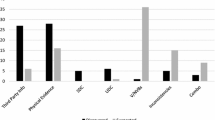Abstract
This study examined the effect of probing for additional information on the accuracy of deception detection. One hundred forty-eight experimental interactions were analyzed to see whether deceivers and truthtellers behave differently when probed and whether probing improved deception detection. Probing produced a number of changes in nonverbal behavior, several of which differed between deceivers and truthtellers. Probing may have communicated suspicion or uncertainty; therefore, deceptive sources were motivated to control their nonverbal demeanor to mask deception-related cues and appear truthful. Probing did not improve detection. Instead, probing receivers considered all sources more truthful. It is suggested that suspiciousness and prior knowledge may affect probing's efficacy.
Similar content being viewed by others
References
Bauchner, J. E. (1978).Accuracy in detecting deception as a function of level of relationship and communication history. Unpublished doctoral dissertation, Michigan State University.
Brandt, D. R., Miller, G. R. & Hocking, J. E. (1980a). Effects of self-monitoring and familiarity on deception detection.Communication Quarterly, 28 3–10.
Brandt, D. R., Miller, G. R. & Hocking, J. E. (1980b). The truth-deception attribution: Effects of familiarity on the ability of observers to detect deception.Human Communication Research, 6 99–110.
Brandt, D. R., Miller, G. R. & Hocking, J. E. (1982). Familiarity and lie detection: A replication and extension.Western Journal of Speech Communication, 46 276–290.
Buller, D. B., & Aune, R. K. (1987). Nonverbal cues to deception among intimates, friends, and strangers.Journal of Nonverbal Behavior, 11 269–290.
Burgoon, J. K., & Hale, J. L. (1987). Validation and measurement of the fundamental themes of relational communication.Communication Monographs, 54 19–41.
Crowne, D., & Marlowe, D. (1964).The approval motive: Studies in evaluative dependence. New York: Wiley.
DePaulo, B. M., Stone, J. I., & Lassiter, G. D. (1985a). Deceiving and detecting deceit. In B. R. Schlenker (Ed.),The self and social life (pp. 323–370). New York: McGraw-Hill.
DePaulo, B. M., Stone, J. I., & Lassiter, G. D. (1985b). Telling ingratiating lies: Effects of target sex and target attractiveness on verbal and nonverbal deceptive success.Journal of Personality and Social Psychology, 48 1191–1203.
DePaulo, B. M., Zuckerman, M., & Rosenthal, R. (1980a). Detecting deception: Modality effects. In L. Wheeler (Ed.),Review of personality and social psychology (pp. 125–162). Beverly Hills, CA: Sage.
DePaulo, B. M., Zuckerman, M., & Rosenthal, R. (1980b). The deceptions of everyday life.Journal of Communication, 30 216–218.
deTurck, M. A., & Miller, G. R. (1985). Deception and arousal: Isolating the behavioral correlates of deception.Human Communication Research, 12 181–202.
Ekman, P., & Friesen, W. V. (1969). Nonverbal leakage and clues to deception.Psychiatry, 32 88–105.
Ekman, P., & Friesen, W. V. (1974). Detecting deception from the body or face.Journal of Personality and Social Psychology, 29 288–298.
Friesen, W. V., Ekman, P., & Wallbott, H. (1979). Measuring hand movements.Journal of Nonverbal Behavior, 4 97–112.
Hocking, I. E., & Leathers, D. G. (1980). Nonverbal indicators of deception: A new theoretical perspective.Communication Monographs, 47 119–131.
Hocking, I. E., Miller, G. R., & Fontes, N. E. (1978). Videotape in the courtroom.Trial, 52–55.
Knapp, M. L. & Comadena, M. E. (1979). Telling it like it isn't: A review of theory and research on deceptive communications.Human Communication Research, 5 15–29.
Kraut, R. (1980). Humans as lie detectors: Some second thoughts.Journal of Communication, 30 209–216.
Kraut, R. & Poe, D. (1980). On the line: The deception judgments of customs inspectors and laymen.Journal of Personality and Social Psychology, 39 784–798.
McCornack, S. A. & Parks, M. R. (1985). Deception detection and relationship development: The other side of trust. In M. L. McLaughlin (Ed.),Communication yearbook 9, (pp. 337–389). Beverly Hills CA: Sage.
Miller, G. R., Bauchner, J. E., Hocking, J. E. & Brandt, D. R. (1981). “.... and nothing but the truth”: How well can observers detect deceptive testimony? In B. D. Sales (Ed.),Perspectives in law and psychology. Volume 3, The jury, judicial and trial process.
Simonton, D. K. (1977). Cross-sectional time-series experiments: Some suggested statistical analyses.Psychological Bulletin, 84 489–503.
Snyder, M. (1974). Self-monitoring of expressive behavior.Journal of Personality and Social Psychology, 30 526–537.
Stiff, J. B. & Miller, G. R. (1986). “Come to think of it...”: Interrogative probes, deceptive communication, and deception detection.Human Communication Research, 12 339–358.
Toris, D., & DePaulo, B. M. (1985). Effects of actual deception and suspiciousness of deception on interpersonal perceptions.Journal of Personality and Social Psychology, 47 1063–1073.
Zuckerman, M., DePaulo, B. M., & Rosenthal, R. (1981). Verbal and nonverbal communication of deception. In L. Berkowitz (Ed.),Advances in experimental social psychology (Vol. 14, pp. 1–59), New York: Academic Press.
Zuckerman, M., & Driver, R. E. (1985). Telling lies: Verbal and nonverbal correlates of deception. In A. W. Siegman & S. Feldstein (Eds.),Multichannel integrations of nonverbal behavior (pp. 129–148). Hillsdale, NJ: Erlbaum.
Zuckerman, M., Koestner, R., & Driver, R. E. (1981). Beliefs about cues associated with deception.Journal of Nonverbal Behavior, 6 105–114.
Zuckerman, M., Spiegel, N. H., DePaulo, B. M., & Rosenthal, R. (1982). Nonverbal strategies for decoding deception.Journal of Nonverbal Behavior, 6 171–187.
Author information
Authors and Affiliations
Rights and permissions
About this article
Cite this article
Buller, D.B., Comstock, J., Aune, R.K. et al. The effect of probing on deceivers and truthtellers. J Nonverbal Behav 13, 155–170 (1989). https://doi.org/10.1007/BF00987047
Issue Date:
DOI: https://doi.org/10.1007/BF00987047




